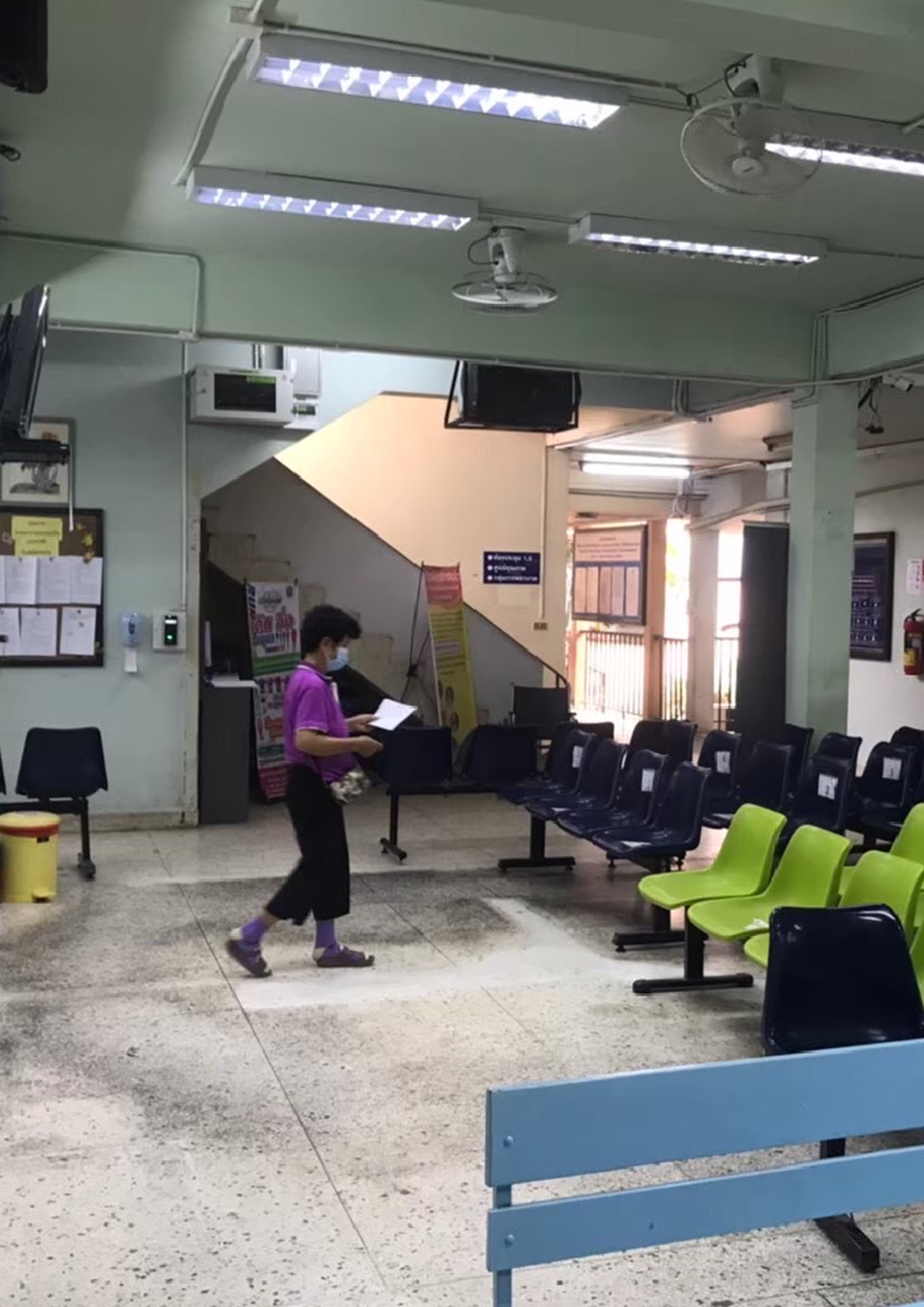Identification of physical environment problems to create participatory design guideline the case of Maewang hospital, Chiang Mai province
Main Article Content
Abstract
Meawang hospital is one of Chiang Mai community hospitals providing secondary care and services. The hospital performs under supervision of Thailand Ministry of Public Health. Maewang outpatient department (OPD) building was built using Ministry of Public Health building standard called OPD building standard No. 3130. The OPD building was built in the 90s and it is in use for services for more than 30 years, which lead to building dilapidation. Moreover, the building has been through several expansion and renovation processes without any concern of environmental impact including the prevention of transmitting and spreading of COVID-19. This study was conducted using observation technique to identify problems in relation to physical setting of Maewang OPD building. Later, architectural plan analysis was conducted followed by interviews with 10 medical staff. The interviews were conducted to obtain insights regarding users behavior in relation to hospital design standards. Obtained data was analyzed using content analysis. Findings showed 5 main factors regarding physical environment problems that can be concluded as ; (1) factors leading to the accumulation of pathogens (2) protocol and measurement to prevent spreading of pathogens (3) OPD service processes (4) renovation plan for the OPD building (5) prevention of accumulation of pathogens in the OPD clinic. Obtain insights can be used as part of participatory design guideline, where hospital policy maker, hospital planners, architects and engineers can use the information for future design development of the hospital. The design guideline is catagorized by each zone of the hospital building.
Article Details

This work is licensed under a Creative Commons Attribution-NonCommercial-NoDerivatives 4.0 International License.
References
Atkinson, J., et al. (2009). Natural ventilation for infection control in health-care settings. Retrived October 13, 2021, from https://www.who.int/water_sanitation_health/publications/natural_ventilation.pdf.
Benedetti, F., et al. (2001). Morning sunlight reduces length of hospitalization in Bipolar Depression. Journal of Affective Disorders, 62(3), 221-223.
Cooper, R. & Berger, C.M. (2009). What’s new in wayfinding? recent developments in hospital signage. Health Facilities Management, 22(4), 23-30.
Dalke, H., et al. (2006). Colour and lighting in hospital design. Optics & Laser Technology, 38(4-6), 343-365.
Davis, M.M. & Heineke, J. (1994). Understanding the roles of the customer and the operation for better queue management. International Journal of Operations & Production Management, 14(5), 21-34.
Dubin, C.H. (2011). Park place a combination of technology and people prove to be the best medicine for securing hospital parking garages. Retrieved July 15, 2021, from https://www.securitymagazine.com/articles/81984-park-place
Department of Medical Services. (2021). Naeo thang wet patibat karn winitchai dulae raksa lae pongkan kan tit chuea nai rongphayaban korani rok tit chuea wairat corona (COVID-19). (In Thai) [Guideline for COVID-19 patient treatment]. Retrived January 5, 2021, from https://covid19.dms.go.th/Content/Select_Landding_page?contentId=155
Design and Construction Division in Department of Health Service
Support Thailand. (2015). Khumue karn okbaep akhan sathan borikan sukkhaphap lae saphapwaetlom phanaek phupuai nok. (In Thai) [Design guideline handbook for healthcare facilities and outpatient department building design]. Retrieved January 2, 2021, from https://dcd.hss.moph.go.th/web/attachments/article/41/OPD.pdf.
Guilemany, J.M., et al. (2011). The importance of smell in patients with bronchiectasis. Respiratory Medicine, 105(1), 44-49.
Hamilton, M.M. (2011). Healing can begin in your waiting room: be mindful of how plants, television, music, and artwork effect the patient experience. Medical Economics - Oradell then Montvale NJ, 88(9), 70-81.
Harris, D.D. & Laura, A.D. (2013). The role of flooring as a design element affecting patient and healthcare worker safety. Health Environments Research & Design Journal (HERD), 6(3), 95-119.
Jones, P. & Peppiatt, E. (1996). Managing perceptions of waiting times in service queues. International Journal of Service Industry Management, 7(5), 47-61.
Jonsson, O., et al. (2014). Furniture in swedish nursing homes: a design perspective on perceived meanings within the physical environment. Journal of Interior Design. 39(2), 17-35.
Konkani, A. & Oakley, B. (2012). Noise in hospital intensive care units-a critical review of a critical topic. Journal of Critical Care, 27(5), 522.e1–522.e5229.
Logan, K. (2012). Toilet privacy in hospital. Nursing Times, 108(5), 12- 13.
Marcus, C.C. & Marni, B. (1999). Healing gardens: therapeutic benefits and design recommendations. Retrived November 10, 2021, from http://catdir.loc.gov/catdir/toc/onix06/98042154.htm
Ministry of Public Health Thailand. (2019). Khumue karn okbaep akhan sathan borikarn sukkhaphap lae saphapwaetlom chabap thuapai karn pongkan karn tit chuea nai sathan borikarn sukkhaphap. (In Thai) [Building design manual for healthcare services, general edition: Preventing infection in healthcare facilities]. Retrived September 12, 2021, from https://dcd.hss.moph.go.th/web/attachments/article/41/OPD.pdf.
Ministry of Public Health Thailand. (2016). Khumue karn okbaep akhan sathan borikarn sukkhaphap lae saphapwaetlom phanaek phupuai nok. (In Thai) [Design manual for healthcare building focusing on outpatient department]. Retrived September 13, 2021, from https://dcd.hss.moph.go.th/web/attachments/article/41/OPD.pdf.
Moore, A. (2012). Estates management: case studies. Dramatic entrance. The Health Service Journal, 122(6300), 10-11.
Pongyen, N. & Waroonkun, T. (2015). Guideline design for improving outpatient building of a community hospital in order to increase satisfaction. Journal of Environmental Design, 1(2), 49-62.
Prugsiganont, S. & Jensen, P.A. (2019). Identification of space management problems in public hospitals: the case of Maharaj Chiang Mai Hospital. Facilities, 37(7/8), 435-454.
Prugsiganont, S. (2020). Waiting space: Exploring public hospital non-clinical areas through a user-focused design approach. Retrived November 15, 2021, from https://backend.orbit.dtu.dk/ws/portalfiles/portal/235521668/Supuck_Prugsiganont_PhD_thesis_final_Dec_2020.pdf.
Schwartz, J., Samet, J.M. & Patz, J.A. (2004). Hospital admissions for heart disease: the effects of temperature and humidity. Epidemiology (Cambridge, Mass), 15(6), 755-761.
World Health Organization. (2021). Rapid hospital checklist: interim guidance. Retrived September 10, 2021, from https://www.who.int/publications/i/item/WHO-2019-nCoV-hospital-readiness-checklist-2020.1
Waroonkun, T. (2018). The environmental factors affecting service satisfaction of community hospital. Journal of Design and Built Environment, 18(1), 19-28.
Yi, L. & Seo, H.B. (2012). The effect of hospital unit layout on nurse walking behavior. Health Environments Research & Design Journal (HERD), 6(1), 66-82.


